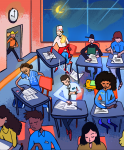It’s exciting to come home around 5 p.m. after a long day of class and midterms – unless of course, you have an evening midterm, in which case you’ll have to spend another two hours drilling into your brain until you get a migraine.
UCLA instructors have the option to hold midterms in or out of class. Professors who hold midterms outside of lecture hours are required to say so on the MyUCLA Schedule of Classes so students know prior to enrollment. If a student is unable to attend one of the midterms, the instructor or department can attempt to accommodate the student. Typically this accommodation would again entail the student taking an exam out of class, which could require them to reorganize their schedule.
This means that although a class may have lectures on Tuesdays and Thursdays, it can have midterms on Fridays. For example, in the life sciences department if a student is unable to attend the midterms, they have to contact the Life Sciences Core Education office by Friday of second week and hope they have a valid reason to take it at another out-of-class time.
This is an inconvenience to students particularly if they have extracurricular activities in the evening or work outside of class that cannot be rescheduled.
Students at UCLA shouldn’t have to take out-of-class midterms. Instructors are responsible for creating appropriately challenging exams that can be taken within the class period. There are only a finite number of hours in the week, and students already dedicate a certain number of them to attending class, discussions, review sessions and office hours. No class should require special treatment, given that numerous departments and professors are able to have exams during class hours.
Frank Laski, professor of molecular, cell and developmental biology and chair of the Life Sciences Core Education office, said that the life science department prefers to do out-of-class midterms so professors don’t waste lecture time. It also gives professors the ability to give two-hour exams, and to deter students from cheating by spreading them out among different exam locations.
But students are paying the university to educate them. It is unreasonable for UCLA to have classes that cover so much material they can’t test students during the class period they signed up for. And even if such classes were justified, there are accommodations, such as two-part exams or take-home exams, that are are completely viable.
The onus should be on the professor, not the student.
The university already asks students to put in tens of thousands of dollars to get a diploma. Not everyone can find someone to cover their shifts on days they have out-of-class midterms, and students can face serious ramifications for missing work shifts.
Irma Ramos, a second-year biology student, has a life sciences class on Mondays, Wednesdays and Fridays, but her out-of-class exams are on Thursdays. On her days off, she works nine-hour shifts back home. In other words, on the days she has her midterms, she can’t work.
“I can’t make up the hours,” she said. “I’m forced to work weekends, which is hard because then I don’t have time to study.”
In effect, a two-hour exam requires Ramos to give up nine hours worth of pay with the only recompense being that she gets to take a life sciences exam in the evening.
Many students also have demanding extracurricular commitments they cannot skip.
Rachael Hunt, a second-year physiological science student who is on the cheer team and has a front desk job, said she had two midterms this year that conflicted with her extracurriculars.
“For my job, I can switch work hours but I can’t switch cheer,” Hunt said.
This comes at a time when a good number of courses, such as those in the life sciences department, are already hybridized to make students watch “lecture videos” outside of class. Adding an additional lecture video to make up for lost time is not unreasonable to ask for.
Professors can be concerned about cheating and schedule night exams to get more space to host midterms or finals. However, considering that many life sciences midterms are multiple choice and completed on Scantrons, professors could create two or three test forms and scramble the order of questions. This would hopefully deter cheating, as looking at a neighbor’s exam wouldn’t help a student because the questions would be out of order.
Moreover, having evening exams on just two arbitrary days is incredibly inconvenient. In terms of work hours, it can mean altering an entire quarter’s work schedule just because exams will cause you to miss two shifts. When exams are in class, students already have the responsibility of scheduling work hours or telling the organizations they are part of that they have class every week at that time and cannot make it. But the irregularity of evening midterms ends up making it difficult to maintain a weekly commitment.
Yes, out-of-class midterms do provide students more time to take exams and allow professors to get more lecture halls to spread students out and help them overcome their urges to cheat. But these benefits do not outweigh the cost students bear. And there’s no reason why a particular department should not be able to create a scheduled structure for holding in-class exams.
After all, an in-class midterm may be a nuisance for professors with a lot to teach. But out-of-class midterms are migraines for students.
